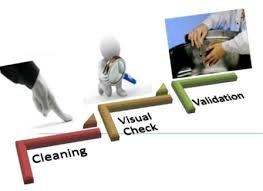Regulatory Expectations from Cleaning Validation

Regulatory Expectations from Cleaning Validation
Cleaning validation is a documented evidence-based process to demonstrate that cleaning procedures effectively and consistently remove residues of products, cleaning agents, and contaminants to predetermined acceptable levels. Regulatory authorities such as USFDA, EMA, WHO, PIC/S, and MHRA set clear expectations to ensure patient safety, product quality, and compliance.
1. Written Procedures & Documentation
-
Cleaning validation must follow an approved protocol and documented SOPs.
-
Maintain a Validation Master Plan (VMP) covering scope, strategy, responsibilities, and acceptance criteria.
-
Ensure contemporaneous documentation aligned with ALCOA+ principles.
2. Risk-Based Approach
-
Regulatory agencies expect a science- and risk-based strategy (ICH Q9).
-
Identify worst-case products based on toxicity, solubility, potency, and batch size.
-
Prioritize multiproduct equipment and critical equipment parts in contact with the product.
3. Acceptance Criteria
-
Establish limits based on health-based exposure limits (HBELs) or PDE (Permitted Daily Exposure) values, not just arbitrary limits.
-
Traditional criteria (still accepted when justified):
-
10 ppm criterion (not more than 10 ppm carryover into the next product).
-
1/1000 dose criterion (not more than 1/1000th of the lowest therapeutic dose of previous product in the maximum daily dose of next product).
-
-
Limits must also cover microbiological contamination.
4. Analytical Methods
-
Analytical methods must be validated (specific, sensitive, accurate, and reproducible).
-
Swab and rinse recovery studies required.
-
Sensitivity must be adequate to detect residues below the acceptance limit.
5. Sampling Approach
-
Direct sampling (swab method): Preferred for equipment contact surfaces.
-
Indirect sampling (rinse method): Useful for hard-to-reach areas.
-
Visual inspection alone is not sufficient but should always be part of acceptance.
6. Number of Validation Runs
-
Typically 3 consecutive successful cleaning cycles are expected for validation.
-
Runs must demonstrate reproducibility and consistency.
7. Revalidation & Continued Verification
-
Required when there are changes in product, equipment, cleaning agents, or cleaning process.
-
Periodic revalidation (e.g., every 1–3 years) or based on risk assessment.
-
Routine monitoring and trending of cleaning verification results expected.
8. Training & Personnel
-
Operators performing cleaning and validation must be trained and qualified.
-
Records of training must be available for inspection.
9. Cross-Contamination Control
-
Regulatory bodies emphasize cleaning validation as part of cross-contamination prevention strategy.
-
EMA and PIC/S require cleaning validation to be linked with toxicological risk assessment (HBEL/PDE).
10. Audit Readiness
Inspectors often ask:
-
Show worst-case product selection rationale.
-
Provide acceptance criteria justification.
-
Demonstrate recoveries and method validation.
-
Show actual swab/rinse reports and equipment logbooks.
✅ Key Regulatory References:
-
USFDA Guidance for Industry: Cleaning Validation (1993, still applicable)
-
EMA Guideline on HBEL (2014)
-
PIC/S PI 006-3: Cleaning Validation
-
ICH Q7: GMP for APIs
-
WHO TRS 937, Annex 4: Cleaning validation.
🎓 Discover one of the best Complete Pharmaceutical Quality Assurance Course available —click below to explore the course that’s shaping future in QA Course skills.

